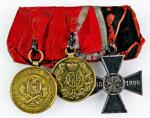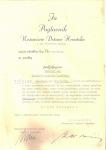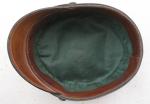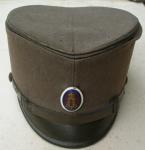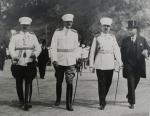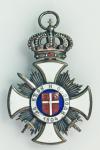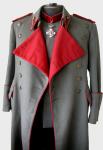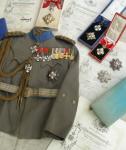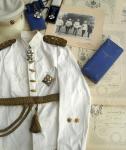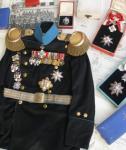
bovec1313
Past Contributor-
Posts
155 -
Joined
-
Last visited
Content Type
Profiles
Forums
Blogs
Gallery
Events
Store
Everything posted by bovec1313
-
Serbia Serbia - What is this War medal ?
bovec1313 replied to lilo's topic in Southern European & Balkan States
Hi Lilo; in Serbian language there are two words for decorations; orders, (higher decorations usually in more classes) and medals (lower decorations, usually in one, sometimes in two classes). Medals can be in form of cross, or round medal or something else (like Albanian medal), but iit is always called a medal. So, even in form of cross, it's officially called Comemorative Medal for the war 1885 - 1886. Unofficialy, it can be called cross (Cross of shame in this case). I hope this will clear the matter. Yes, cross was often awarded to foreign recipients, officers and red cross personel, who were supporting Serbian army. So it's no boubt that your Lieutenant General John Wimburn LAURIE was eligible to this award. -
Serbia Serbia - What is this War medal ?
bovec1313 replied to lilo's topic in Southern European & Balkan States
One more picture, an interesting medals clasp of an veteran of war 1876 - 1885. He is wearing (Gold?) Medal for zealous service 1877 - 1878, Commemorative medal for war 1876 - 1878 and Commemorative medal for war 1885 - 1886 -
Serbia Serbia - What is this War medal ?
bovec1313 replied to lilo's topic in Southern European & Balkan States
Hi Lilo, Medal for War 1885 - 1886 can be as well attached on triangular ribbon. What is most interesting, medal had a nick name ''Cross of Shame''. I'm attaching text from my book about this medal, if you're interesting.... Commemorative Medals for the war with Bulgaria 1885 – 1886 After war with Bulgaria had ended, king Milan had on the 19th of February (3rd of march), a day after Bucharest peace treaty had been signed, instituted Commemorative Medals for the war with Bulgaria 1885 – 1886 (Collection of the Acts and Regulations, XLII, 57). The right to wear of this medal had all officers and soldiers of the active army and the 2nd call who participated in the war or were mobilized and all civil persons who performed their duties on the battlefield. By the Regulation issued in 1898 it was additionally specified that medal can be bestowed ass well to all active officers who remained in their garrisons and all civil persons fit to military service (Official Military gazette, 1898, p. 496 – 497) . No tax needed to be paid for this medal. Lists of decorated persons were kept in the Military commands. After the death of the recipient medal remained with the next of kin. Commemorative Medals for the war with Bulgaria 1885 – 1886 has the shape of the 42 mm wide straight armed cross, made from forged iron. Cross has raised edges with the grained surface. Left arm is bearing the date ' 1885 ' while date ' 1886 ' is place don the right arm. The central medallion is embellished by a six-pointed star with rays between the arms. The medallion on the reverse of the cross bears military trophies, crossed flags and cannon barrels and rifles. Cross is lacquered in black and it has polished raised parts. Eye-loop is minted together with the cross in one piece. Ribbon is black, 28 mm wide with thin red stripes at the edges. It is folded similar to the ribbon of Silver medal for bravery. Sometimes we can find ribbons folded in triangle, but this was against the regulations. Medal was wearied on the left side of the chests. Acquisition and selling of the Commemorative Medals for the war with Bulgaria 1885 – 1886 was entrusted to the firm of Albert Benedikt, which was selling it for 50 paras (half of dinar) apiece. It is not know in which workshop medals were manufactured. Because of the simple execution it is possible that they were produced in the workshop of Benedikt himself and furnished with ribbons made in Vienna. Gloomy image of the medal and the fact that Serbia suffered a humiliating defeat war with Bulgaria contributed to the medal's nick name 'Cross of shame'. Medal was accompanied by very attractive awarding document. Document is showing an allegory image of woman, standing on the pedestal with cipher of king Milan. A crowned double-headed eagle from Serbian coat of arms is placed behind the woman. Form were printed in photo-lithographic workshop of General Staff. -
I've found quite amazing story (and I believe a well known) about British Lieutenant Colonel Jack Churchill and his captor, German hauptmann Johannes Thörner. Lieutenant Colonel Jack Churchill was a commander of British Two Commando unit in Yugoslavian coast. Thorner, a commander of III/118 Div. had fought heavily with his unit against Churchill and finally defeated and captured him on June 1944. Thomas disregarding a standing order that all Commandos were to be executed and saw to it that prisoners was treated correctly. Before leaving Thorner's care Churchill wrote a letter to the German officer thanking him. Thorner was subsequently captured by the Americans near Vienna and Yugoslav authorities demanded that he be turned over to them and most likely sentenced to death. To concince the Americans of his good character, Thorner showed them the letter from Churchill. Back home in UK, Churchill guesses that Thorner had probably been take a prisoner and went to Allied authorities and offered to appear in Thorner's defense. A story had a happy end, Thorner wasn't handed over to Yugoslav authorities. By some luck I come to a passion of a rare document, a decree of highest Croatian order, Order of the Iron Threefoil Class I (a kind of parallel to German KC; however only three (!!!!!) Class I with or without oak branches (for bravery) were awarded to Croatians during WWII; 15 Class II orders, 114 Class III orders and 833 Class IV orders); making this decoration a rarest Croatian military award.) Thorner was decorated with Order of the Iron Threefoil Class I on October 1944, ''as a recognition for, being a commander of a stronghold on island Brac, after repelled 10 enemy attacks and been left without hand grenades, he had personally leaded his men into attack, and forced enemy together with LieutColonel Churchill, commander of Allied forces on island Vis, to surrender; and thus destroyed supreme enemy who landed on island.'' Decree is signed by Croatian Fürher Ante Pavelic and Minister of Defense Forces Ustasha general Ante Vokic. I'm posting a picture a famous Churchill letter (from the book Partisans and Guerilas by Ronald H. Baqiley) and Decree from my collection.
-
Orders of St. Sava had been produced by many workshops; each of them had specific image of the saint. There are so many of them and for me it was always fascinating to get all the variants in collection. Here is complete (I hope) collection of images; from Viennese producers from 1883 to latest image from German workshop of Zimmermann. You can see how image of the sain had changes during the time. Collector normaly distinguished only ''red robe'' and ''gree robe'' images. By the way, these are two pages from my book about Serbian decorations. On external link you can see better, I beleive. Still don't know how to post larger pics here. http://yfrog.com/j1savapics2j
-
Dear Jef, I'm affraid you're asking quite impossible thing; At bombing of Belgrade on April 7, 1941 one of the first German bomb had hit Chancellery of Royal Orders and all archives went in flame. So, no lists of recipients exist anymore, to my knowledge. The only exception is list of recipients of Order of the Star of Karageorge which still exist.
-
-
I'm enclosing pics of my Serbian officer's cap; acording to its shape, cap is from early period of WW1, (before Albanian retreat) Cap has gold braid for staff officers on the top, but it's quite dark due to age. Caps after WWI were broader and had larger visor.
-
Serbia Serbia - Officers in white summer blouses
bovec1313 replied to bovec1313's topic in Southern European & Balkan States
Can somebody advice how to post larger pics? thanks in advance -
Interesting picture, three Serbian generals in three diferent sommer blouses; from left to right: Guards brigade general in Guard's sommer blouse (note olive shaped buttons and guard's belt) Divisional general in (oridinary) white sommer blouse Brigade general in white parade blouse ''mundir'' (two rows of buttons) All three have regular summer white officers' caps
-
Hi Andyg, great picture of general Kostic (1883 - 1595) In wars 1912 - 1918 he was a company and later batallion commander, some of his posts afre WWI: after wa he was Cheaf of military department at State railways; form 1925 to 29 commander of 6th and 43th Infantry regiment, in 1929 he was a commander of IV. infatry school for non-comssioned officers, from 1934 he was commander of Infantry in Adrian (military) Region, for some time King's Adjutant., in 1935 he was commander of Sava military district, 1937 - Inspector general of the Infantry; 1940 Commander of the Gendarmery. POW in April 1941. promoted to Brigade general in 1930, Division general in 1935. Decorated wit Order of the Star of karageorge with Swords Class IV and Class III. He was decorated with Order of the Star of Karageorge with words Class III very early, in summer 1914. This was one of highest Serbian military awards, only 118 Serbian officers alltogether was decorated with this order. What's most interesting, Kostic' Class III order is of Viennese production, made before WWI. I'm attaching two more picture of general Kostic, as young leftenant-colonel and as a general. His Star of Karageorge was obviously damaged from constant wear, what can be seen from second picture. Below is his actual award, owned by my friend collector, who got it from Kostic' family.
-
Kingdom of Yugoslavia - general's blouse
bovec1313 replied to bovec1313's topic in Southern European & Balkan States
I was talking before about light blue been generals' colour. Infatry had red branch colour. Here is a nice example of the Infantry colonel service blouse & greatcoat. Geratcoat has red lappes; generals' one would have blue. This one is unfortunately not from my collection; owner doesn't want to sell ( my coleague collector), but uniform is my size and suits me perfectly, as been made for me. -
Kingdom of Yugoslavia - general's blouse
bovec1313 replied to bovec1313's topic in Southern European & Balkan States
Common service uniform of the division general, with ''axelbenders'', or aquilettes of the Honorary King's Adjutant. It's interesting that in Yogoslav Royal Army generals' colour was light blue; even greatcoats have blue lappels. All other armies more or less use red color for generals. However, generals' trousers have red lampasses. -
Kingdom of Yugoslavia - general's blouse
bovec1313 replied to bovec1313's topic in Southern European & Balkan States
I'm happy that ''Herr general'' is pleased; collecting uniforms I have especial interest on generals' uniforms of Kingdom of Yugolsavia and K.u.K. I'm attaching sommer blouse of Division General (two stars) of the Royal Guard (buttoms are in form of ''olive'') and there is a Cypher of King Alexander ''AI'' on shoulder board. Cypher AI was placed on shoulder boards only for the Royal guard or for the members of so called ''War house of His Majesty the King'', which means royal adjutants, royal orderly officers etc. Guard officers wear as well special parade belt called ''kicanka''. I don't know what English translation of this word would be. -
Yugoslavia Order of the National Hero
bovec1313 replied to Bob's topic in Southern European & Balkan States
To available data, 476 orders were made in Moscow mint; which is quite high number; Production in Muscow mint lasted until end of October 1944. As Zagreb was liberated in May 1945, it seems that there was no need for additional orders. Namely, mint IKOM was located in Zagreb. IKOM was in fact old and well known workshop of Knauss Brothers (for some time Griesbach & Knauss); before WW2 they were producing orders in Kingdom of Yugoslavia, in yeasr 1941 - 1945 they were main producer of decorations and badges in Independant State of Croatia (NDH); after the war as side had turned, they started to produced decorations for Socialistic Yugoslavia. Their products between 1945 - 47 are halmarked with ''BK''. After 1947, company was nationalised and renamed to ''Industrial Mint (Kovnica in Croat) Orekovic Marko'' or IKOM. Marko Oreskovic was one of early national heroes. So, soon after May 45 Knaus Brothers started with Yugoslav production of Order of National Hero. I agree with Luka that gilded Orders of national hero are not popular between colectors; I would say there are two reasons; firts, ''live'' awarded person always received solid gold piece. Second, gilded bronze pieces were made almost entirely as museum piecse or 2nd (copy) items for recipients, and almost all fakes on the marked are made from gilded bronze. It's cheaper. -
A piece from my collection, a parade blouse of division general (two stars general), with apropriate selection of decorations; It's interesting that generals ranks have stars on sleeves (one, two or three) and not on epaulettes or shoulder boards. Large epaulettes for generals were not used after 1928. Unfortunately moths had some pleaseure with the lower part of a blouse.
-
Yugoslavia Order of the National Hero
bovec1313 replied to Bob's topic in Southern European & Balkan States
Dear all, as I'm a new kid on the block, some interesting fact about Order of National Hero (to my knowledge) The first decorations were finished in September 1944. Until end of WWII orders were manfactured in Moscow workshop Monetnii Dvor. After the war production was taken over by workshop of Brothers Knaus in Zagreb (later mint IKOM). While Russiand made decorations were produced exclusively from gold, IKOM had produced beside gold as well pieces made from gilded bronze for museums or as a duplicates. Order of the National Hero was bestowed until 1973 and alltogether 1364 decorations were made. Out of this munber, 903 were made posthumly. Orders to the posthumly decorated people were not bestowed to their families or next of kin, but were sent directly to Militay museum in Belgrade; where they're (and still are) hanged on a wall. All these orders were made from gilded tombac (bronze), but they differ from present fakes (originals were manufactured un very fine way). Russian Orders were made of solid gold, 22 carat (916/1000) and are not hallmarked. (39,1 g) Ikom orders were made of 18 karat gold (750/1000) and are hallmarked with Yugoslav hallmark for gold. hey are made from two parts (front and rear) which are soldered together. Visually, they're all very similar. from left to right : Ruusian gold order, Ikom gold, Ikom gilded bronze -
Serbia Serbia, Yugoslavia, Orders and Decorations 1858-1941
bovec1313 replied to a topic in Southern European & Balkan States
hello everybody; I'm the author of this book; I agree that shipping cost are killing, but I can offer a better price for members of this forum; -23 BP discount of total price, or 100 BP for Book & shipping. regards, bovec1313 (Pavel)

